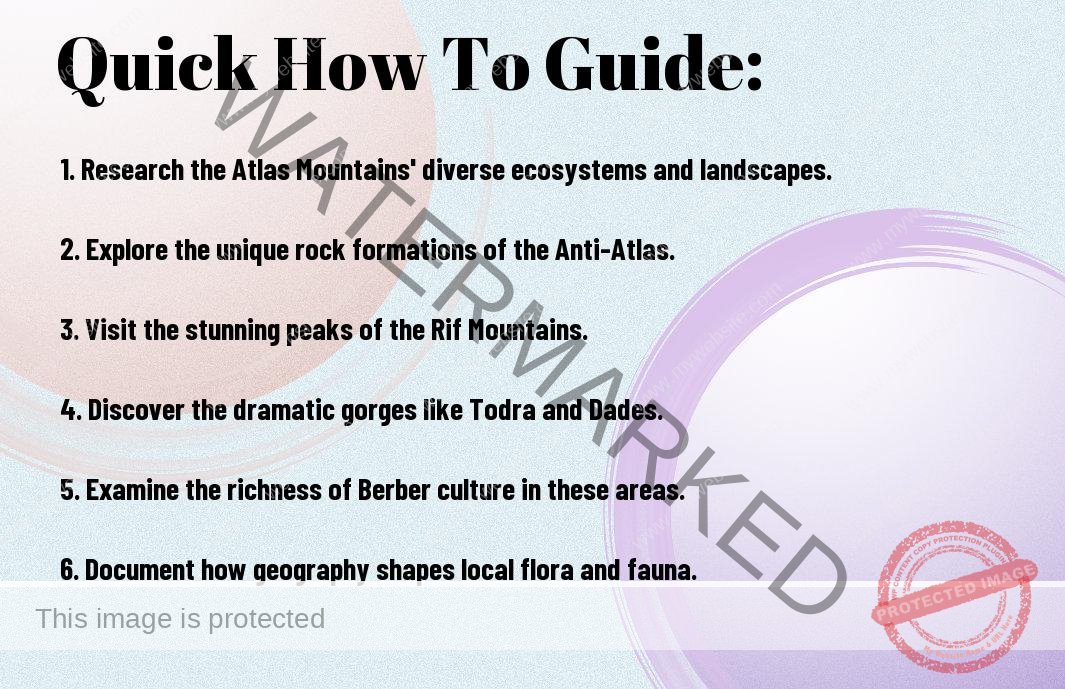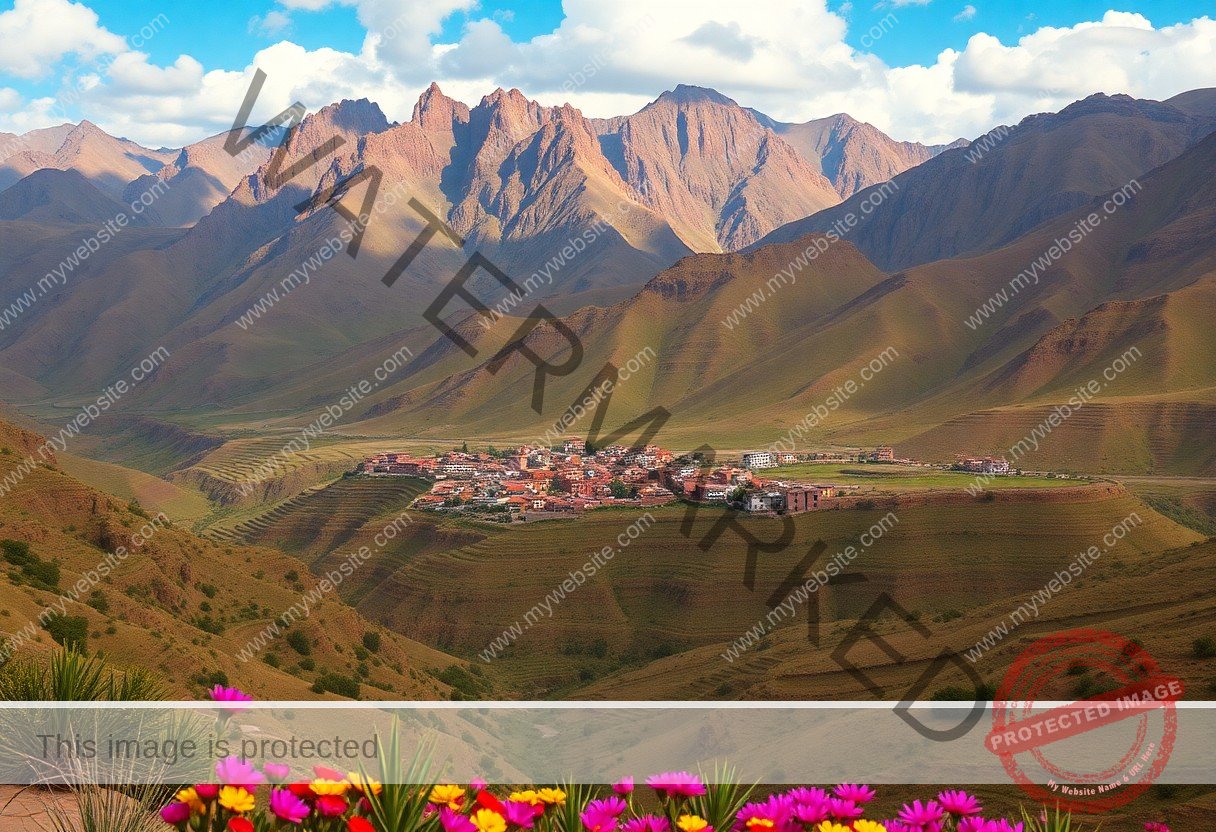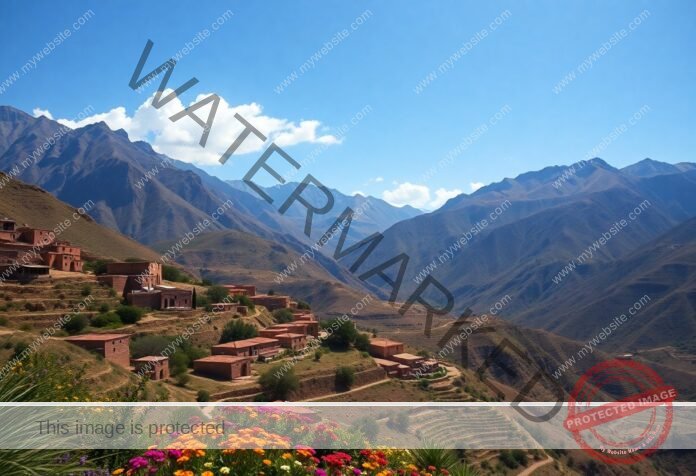You may be surprised to discover that Morocco’s mountainous terrain is a treasure trove of geographical wonders that showcase the country’s natural beauty and ecological diversity. From the majestic Atlas Mountains to the rugged Rif range, these landscapes offer unique sights, rich ecosystems, and opportunities for adventure. In this blog post, you’ll explore the distinctive features that define Morocco’s mountains, uncovering secrets that will enhance your appreciation for this captivating region.
Advertisement
Key Takeaways:
- Atlas Mountains: The backbone of Morocco, characterized by high peaks, valleys, and rich biodiversity, offering stunning landscapes and numerous trekking opportunities.
- Rif Mountains: Known for their lush greenery and Mediterranean influence, these mountains are significant for their unique flora and traditional Berber culture.
- Anti-Atlas Range: A lesser-known area featuring arid landscapes and dramatic rock formations, highlighting Morocco’s geological diversity.
- Geological Diversity: Morocco’s mountainous areas are marked by a variety of geological features, including limestone massifs and volcanic rocks, showcasing a rich geological history.
- Climate Variations: The mountainous terrain creates microclimates, leading to diverse ecosystems and agricultural practices that differ from the coastal and desert regions.

How to Explore Morocco’s Mountainous Terrain
While exploring the breathtaking Atlas Mountains, you will discover a landscape filled with exciting opportunities for adventure and cultural enrichment. To ensure you make the most of your journey, familiarizing yourself with the terrain is vital. A good map or a reliable GPS app set up on your smartphone will keep you on track, while also providing you with a resource for learning about the natural landmarks and local flora and fauna. Also, consider hiring a local guide who possesses extensive knowledge of the area, which can enhance your experience significantly. You should be prepared for various weather conditions and ensure you’re equipped with appropriate hiking gear.
Tips for Navigating the Atlas Mountains
You will encounter various trails when navigating the Atlas Mountains, each offering its unique challenges and wonders. Here are some tips to ensure your safety and enjoyment throughout your adventure:
- Always carry plenty of water and snacks, as food resources can be scarce in remote areas.
- Wear sturdy hiking boots appropriate for rocky terrain to prevent injuries.
- Take your time and pace yourself to enjoy the stunning views without overexertion.
- When trekking, stick to marked trails and avoid wandering off to prevent getting lost.
- Keep your camera handy, as every turn offers picturesque photo opportunities.
Any adventure in the mountains demands awareness of the environment, so be attentive and respect local wildlife and customs.
Suggested Routes and Destinations
Clearly, careful planning will lead you to some of the best trails and destinations within the Atlas Mountains. Starting your journey in Imlil, a village that serves as a gateway, offers a fantastic blend of adventure and cultural experiences. From there, you can trek to the iconic Toubkal, which is the highest peak in North Africa, or explore the waterfalls and verdant valleys dotted throughout the region. There are countless villages such as Aroumd and Echmoun that allow you to immerse yourself in Berber culture while continuing your exploration.
Mountainous regions in Morocco are rich in variety and offer an unforgettable experience for outdoor enthusiasts and culture seekers alike. The lush valleys, rugged peaks, and unique Berber villages create an extraordinary backdrop for your exploration. As you journey through this stunning terrain, the scenic routes will provide you with insights into the region’s natural beauty and historical significance, making for a truly enriching experience in Morocco’s mountains.

Unique Geographical Features
Some of the most stunning geographical wonders can be found throughout Morocco, a land characterized by its dramatic landscapes and varied topography. From the soaring mountain ranges to vast deserts, the country’s geographical features offer incredible sightseeing opportunities. If you are eager to explore the mountainous terrain, you can learn more about the stunning Morocco Mountains that define the region’s unique charm.
The Majestic Atlas and Anti-Atlas Ranges
While traversing Morocco, you will undoubtedly be captivated by the majestic Atlas and Anti-Atlas ranges. The Atlas Mountains, stretching over 2,500 kilometers, are famed for their dramatic peaks, picturesque valleys, and traditional Berber villages nestled in their slopes. Hiking enthusiasts will find numerous trails that lead to breathtaking vistas, each offering glimpses of Morocco’s diverse flora and fauna. Meanwhile, the Anti-Atlas Mountains provide a different yet equally impressive landscape characterized by ancient volcanic formations and striking rock formations that showcase the power of nature at work.
Natural Parks and Reserves
With its rich biodiversity and a commitment to preserving its natural wonders, Morocco boasts an impressive array of national parks and reserves. These areas protect the unique ecosystems found in the country’s mountainous regions, allowing you to witness diverse wildlife and stunning plant life in their natural habitat. For instance, the Toubkal National Park is home to the highest peak in North Africa, where thrill-seekers can scale Mount Toubkal and enjoy awe-inspiring views.
Reserves such as the Souss-Massa National Park and Imlil Valley not only protect endangered species, like the Barbary macaque but also offer ample opportunities for eco-tourism and outdoor adventures. In these remarkable settings, you can immerse yourself in the beauty of nature as you hike, bird-watch, or simply enjoy the tranquility found in these protected areas. Each reserve you visit provides a unique perspective on Morocco’s rich ecological heritage.
Factors Influencing the Terrain
Many elements come together to shape the magnificent landscapes you see in Morocco’s mountainous regions. These factors work in tandem, creating unique geographical features that are both stunning and intriguing. Here are some key factors that influence the terrain:
- Geological history and formation
- Climate and weather patterns
- Human activity and land use
Thou would do well to consider how these elements interrelate, giving rise to the rich tapestry of Morocco’s mountainous terrain.
Geological History and Formation
Factors contributing to Morocco’s distinctive mountainous terrain begin with its geological history. The very foundation of the Atlas Mountains stretches back millions of years, shaped by tectonic activity, volcanic eruptions, and erosion. These processes have created formidable ranges, like the High Atlas, with peaks that soar high into the sky, as well as the Anti-Atlas, characterized by its rugged charm. Your understanding of these formations deepens when you consider the age of the rocks and minerals that comprise them, including the fascinating presence of fossils that narrate ancient life.
Additionally, sedimentation has played a key role in molding the valleys and plateaus of the region, creating a diverse landscape that hosts various ecosystems. The interplay between these geological processes continues to attract researchers, adventure seekers, and nature lovers alike, all eager to explore the terrain’s dynamic past. Thou will appreciate how this geological narrative contributes to the breathtaking views that surround you.
Climate and Weather Patterns
Geological factors are not the only influences that define Morocco’s mountainous terrain; climate and weather patterns shape the ecosystems dwelling within these peaks. The country experiences a diverse range of climates, from Mediterranean along the coast to semi-arid and even alpine climates in the higher elevations. This variation in climate leads to significant differences in vegetation and biodiversity, making each region unique in its offerings to you as an explorer.
It is important to understand that these climate patterns also affect erosion and sedimentation rates, further sculpting the landscapes you find yourself wandering through. For instance, temperatures can range dramatically from day to night, and seasonal changes bring rain or snow, contributing to both the breathtaking beauty and the formidable challenges of the terrain. As you traverse these mountains, you can see how the interplay of geology and climate produces a captivating environment rich in natural wonders.
How to Experience Local Culture in the Mountains
Now, if you are looking to immerse yourself in the rich tapestry of local culture while exploring Morocco’s mountainous terrain, community engagement is vital. Engaging with local communities will not only enhance your experience but also create meaningful connections. Here are some tips to ensure you engage respectfully and effectively:
Community Engagement Tips
- Learn a few words of Arabic or Berber to break the ice.
- Seek out opportunities to participate in local festivals or gatherings.
- Offer to help with daily tasks, such as cooking or farming.
- Inquire about any local crafts or skills that you can learn from artisans.
- Support local businesses by purchasing handmade goods.
Perceiving the beauty of connections forged with the locals will deepen your understanding of their way of life.
Traditional Crafts and Skills
One of the most captivating aspects of Moroccan mountainous culture is its artisanal craftsmanship. You will find that each village possesses its unique style, from exquisitely woven rugs to intricate pottery. Many artisans are eager to share their techniques with visitors, allowing you a hands-on experience in traditional crafts such as weaving, woodworking, or leatherworking. This not only enhances your appreciation of these skills but also supports the continuation of these age-old practices.
Another vital element of exploring local crafts involves visiting markets and workshops where artisans create their masterpieces. You can engage directly with these skilled craftsmen, listen to their stories, and learn about the materials they use. Many towns also offer workshops or demonstrations that are designed for visitors, allowing you to try your hand at a craft while guided by an expert, ensuring you take home not just a souvenir but a tangible memory of your experience in the mountains of Morocco.
Practical Tips for Travelers
Once again, as you prepare for your journey through Morocco’s breathtaking mountainous terrain, it’s necessary to keep certain practical tips in mind to ensure a wonderful experience. The diverse landscape and unique culture present both opportunities and challenges, so being well-informed will enhance your adventure. Here are some tips to guide you:
- Research the best seasons to visit; spring and autumn are ideal for hiking.
- Consider hiring a local guide for an authentic experience and enhanced safety.
- Familiarize yourself with local customs and etiquette to show respect.
- Stay hydrated, especially when trekking at higher altitudes.
After following these suggestions, you will be well-equipped to enjoy the natural beauty and cultural richness of Morocco. For more insights, check out Natural wonders of the Maghreb, Morocco – Deposits.
Essential Gear and Preparation
You should invest in quality gear that meets the demands of Morocco’s varied landscapes. Essential items include lightweight hiking boots for rugged trails, a sturdy backpack for day hikes, and appropriate clothing that can handle both the bright sunlight and cooler mountain temperatures. Additionally, don’t forget to pack a good map or download reliable navigation apps to guide your way through the twists and turns of mountainous paths.
When trekking, bring along high-energy snacks and a portable first-aid kit for any minor injuries that may occur on your journey. Furthermore, it’s beneficial to carry a reusable water bottle and a water purification method to ensure you stay hydrated and healthy throughout your adventure.
Safety Considerations
One of the key aspects to keep in mind is your safety while exploring Morocco’s mountainous regions. Be aware of the varying altitudes, as sudden elevation changes can lead to altitude sickness. It’s advisable to acclimatize properly before begining on higher trails. Additionally, always inform someone about your plans, especially if you intend to trek alone or in remote areas.
Safety also involves understanding the local environment. Be attentive to weather changes, carry necessary gear such as rain jackets, and avoid risky paths during inclement weather. Develop a good understanding of wildlife you may encounter, and stay on marked trails to minimize potential hazards in the wilderness.
How to Capture the Beauty of Morocco’s Mountains
For those looking to capture the allure of Morocco’s mountainous landscapes, having the right approach and techniques can make all the difference. Venturing into areas like the Atlas Mountains offers photographers not just stunning vistas but also unique lighting conditions throughout the day. Whether you’re an amateur or professional, enhancing your skills can help you immortalize the picturesque scenery. For further insights, check out What is special about Atlas Mountains | Morocco Toubkal to get an idea of what makes this region a photographer’s paradise.
Photography Tips
Beauty often lies in detail, and capturing the intricacies of Morocco’s mountainous terrain is no exception. Here are some photography tips to help you make the most of your experience:
- Use a wide-angle lens to encompass the vastness of the landscapes.
- Take advantage of the golden hour—early mornings and late afternoons offer soft lighting.
- Experiment with different perspectives to find unique compositions.
- Incorporate local elements, such as traditional villages, to add context and depth to your photos.
After you’ve taken all these into consideration, you’ll find yourself better equipped to capture those breathtaking moments.
Best Times for Scenic Views
With its varied climate and altitudes, Morocco’s mountains present different scenic views throughout the year. Spring and autumn are particularly advantageous times for photography because of the mild weather and vibrant colors in the foliage. Snow-capped peaks stand out beautifully during the colder months, offering dramatic contrasts, whereas summer showcases lush greenery and expansive valleys.
Best of all, planning your trip around these seasons not only ensures stunning vistas but allows for a more comfortable exploration. Ideal times to visit often provide clearer skies and more vibrant colors, allowing you to make the most of each photographic opportunity.
Final Words
As a reminder, your adventure through Morocco’s mountainous terrain reveals a tapestry of unique geographical wonders that are both breathtaking and diverse. From the iconic peaks of the Atlas Mountains, where you can immerse yourself in stunning landscapes and rich cultures, to the awe-inspiring Sahara’s edge, each region offers extraordinary experiences that cater to outdoor enthusiasts and cultural explorers alike. The interplay of high-altitude valleys and rugged summits creates a distinct environment that invites you to research into activities such as trekking, rock climbing, and discovering the vibrant Berber villages that dot the landscape.
Additionally, the varied climate and geography foster a remarkable biodiversity that supports an array of flora and fauna. As you traverse these mountainous terrains, you’ll appreciate the contrast between the arid, stark beauty of the High Atlas and the lush greenery found in the lower valleys. This enchanting mix not only emphasizes Morocco’s natural splendor but also exemplifies the deep connection between its terrain and the lives of its inhabitants. So, as you set out to explore these geographical wonders, keep in mind the myriad stories and cultural richness that accompany every peak and valley.
FAQ
Q: What are the primary mountain ranges in Morocco?
A: Morocco is predominantly defined by the Atlas Mountains and the Rif Mountains. The Atlas Mountains extend across central Morocco, serving as a dramatic backdrop with peaks like Toubkal, the highest in North Africa. The Rif Mountains, located in the northern part of the country, are known for their steep terrain, lush forests, and picturesque views bordering the Mediterranean Sea.
Q: How do the geographical features of Morocco’s mountains influence the climate?
A: The mountainous terrain of Morocco creates diverse climatic conditions. The Atlas Mountains act as a barrier, causing the northern regions to experience a Mediterranean climate, while the southern areas receive less rainfall and exhibit a semi-arid climate. This variation supports an array of ecosystems, ranging from cedar forests to arid landscapes.
Q: What are some notable geographical landmarks found in Morocco’s mountainous regions?
A: Key geographical landmarks include Jebel Toubkal, which is the highest peak in the Atlas range and a popular trekking destination, and the Todra Gorge, known for its stunning rock formations and dramatic cliffs. Other landmarks include the Ouzoud Falls, one of the tallest waterfalls in North Africa, and the remarkable views from the peaks of the Rif Mountains, which showcase the rich landscapes of the region.
Q: How do Morocco’s mountains contribute to biodiversity?
A: The varied elevation and microclimates within Morocco’s mountainous regions foster a high degree of biodiversity. These areas are home to unique plant species, such as the endangered Argan tree, and a variety of wildlife, including the Barbary macaque and several endemic birds. The ecological diversity is vital for maintaining the balance of the environment and attracts researchers and ecotourists alike.
Q: What cultural significance do the mountains hold for local communities in Morocco?
A: The mountains of Morocco are not only stunning natural features but also hold cultural importance for local Berber communities. They are integral to traditional lifestyles, including agriculture and artisan crafts. Many villages in the Atlas region maintain unique customs, music, and festivals influenced by the mountainous environment. Additionally, these regions are vital for tourism, offering opportunities for hiking, trekking, and cultural exchanges.

